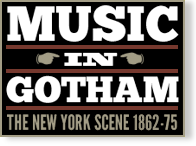Central Park Garden Concert
Event Information
Venue(s):
Central Park Garden
Conductor(s):
Theodore Thomas [see also Thomas Orchestra]
Price: $.50; $1-2, private box
Event Type:
Orchestral
Record Information
Status:
Published
Last Updated:
13 May 2025
Performance Date(s) and Time(s)
04 Jun 1874, 8:00 PMPerformers and/or Works Performed
Citations
Includes program; Haydn’s symphony was performed in its entirety.
“Night after night the Central Park Garden is attended by crowds of delighted visitors, although the weather has not yet been warm enough to render out-of-door amusements essential. When the theatres are all closed, and such cool resorts as that which Mr. Thomas offers are the only available places of amusement, it is easy to see that the Garden will hold but a part of those who will seek its attractions.
The usual ‘classical’ night recurred last evening. Beethoven, Mendelssohn, Liszt, Haydn, Wagner, Lux, Gounod and Strauss were all represented in the programme, and it is easy to see that there was a much greater variety of music than the word ‘classical’ is usually supposed to imply.”
“The classical night of the week, Thursday, drew a large house to the favorite summer garden of the metropolis last evening. Fashion, albeit the chilly weather forbade any extensive exhibition of summer fabrics, was well represented on the occasion, and the habitués of the opera sat around the tables listening to the magic strains that enrich the mind with the garnered treasures of a century of music. The concert began with a march of Liszt (Huldigungs), a tribute of homage to some one of his royal patrons, which Mr. Thomas has made as familiar to New York ears as a nursery melody. Then the overture to ‘Fidelio,’ the last of the four colossal works which Beethoven wrote as introductions to his only opera, was delivered by the band with that heartiness, that ‘at homeness’ and fervid expression that betokens perfect orchestra playing. A lovely Adagio religioso from Mendelssohn’s ‘Hymn of Praise’ followed, and was interpreted with the delicacy of a poet in an idyl. A rude, blatant outburst of the brass instruments ushered in the ‘Fliegende Holländer’ of Wagner, and in the selections from this early work of this now notorious opera there was little if any repose for a sensitive ear—only climax after climax, like Helion upon Ossa. Grand old Papa Haydn had the second part of the programme all to himself. His second symphony (Breitkopf and Haertel edition), in D minor—one of the Prince Esterhazy concert series—was given, and in it the best characteristics of the band came out in strong relief. Nothing could be more dainty and delicious than the rendering of the lovely andante, and the minuet (it is not a minuet in the strict sense of the word) was applauded to the echo. Such music has a healthy effect at these concerts. The greatest of all modern overtures, ‘William Tell,’ was next played, and was followed by a very clever, yet diffuse orchestration of the celebrated prayer from ‘Der Freischütz,’ by Lux, the Rhenish composer, of whom we have already spoken, and who will undoubtedly, thanks to Mr. Thomas, become popular on this side of the Atlantic as an orchestral adapter. The new Vienna waltzes of Strauss are too well known to need a word here, and Thomas’ orchestra has made the Tarantella-like ‘Saltarello’ of Gounod a household word in New York. It was an entirely enjoyable concert, and the demeanor of the audience showed that the New York public can fill a summer garden for the sake of music alone. Theodore Thomas and his followers constitute the attraction at Central Park Garden, and the weather, which so materially affects theatres, seems to have no deleterious influence upon these concerts.”
“It has been sorry weather for music al fresco, and the breezes which sweep through the Central Park Garden have been rude and damp; nevertheless, the concerts have drawn large audiences, and on Thursday, especially, the hall was crowded, as, indeed, on the classical nights, it almost always is. The Symphony this week was Haydn’s in D, No. 2 of the Breitkopf and Härtel edition—or No. 1 according to some arrangements—a composition belonging to that exuberant period of Haydn’s youth when he was turning out symphonies at the rate of one every quarter, and minor pieces for the orchestra, the quartet, and a vast variety of solo instruments, almost as fast as he could throw the notes upon the paper. Nothing impresses us more forcibly in listening to selections from the enormous mass of his music than the apparently inexhaustible fertility of a genius which could create so rapidly and yet repeat itself so little. Of course there is a strong resemblance among the one hundred and forty symphonies, great and small, which Haydn left to the world; there are phrases, cadences, and modulations which are almost stereotyped; but the beauties of one are distinct from the beauties of another. It is the same sunlight which plays over them all, but the forms that it gilds are perpetually shifting and changing. How simple and unpretentious these good old symphonies appear by contrast with the rich and high-colored works of our restless and more exacting time. There are no bold and startling effects in them. The tone of the picture is always subdued, but the tints are exquisitely blended, the light is cheerful, and the workmanship is perfectly finished. The four movements of this Symphony in D consist of an Adagio introduction, followed by Allegro; an Andante, a Minuet; and an Allegro spiritoso. The second of these is the best known—one of those beautiful and tender melodies whose characteristic charm is so familiar to all lovers of Haydn’s music.
The first part of the programme contained Liszt’s beautiful ‘Huldigungs Marsch,’ the overture to ‘Fidelio’ (No. 4), the Adagio Religioso from the symphonic part of Mendelssohn’s ‘Hymn of Praise,’ and some admirable selections from Wagner’s ‘Flying Dutchman,’ which we feel bound to say were received with more applause than either Haydn or Mendelssohn.”

